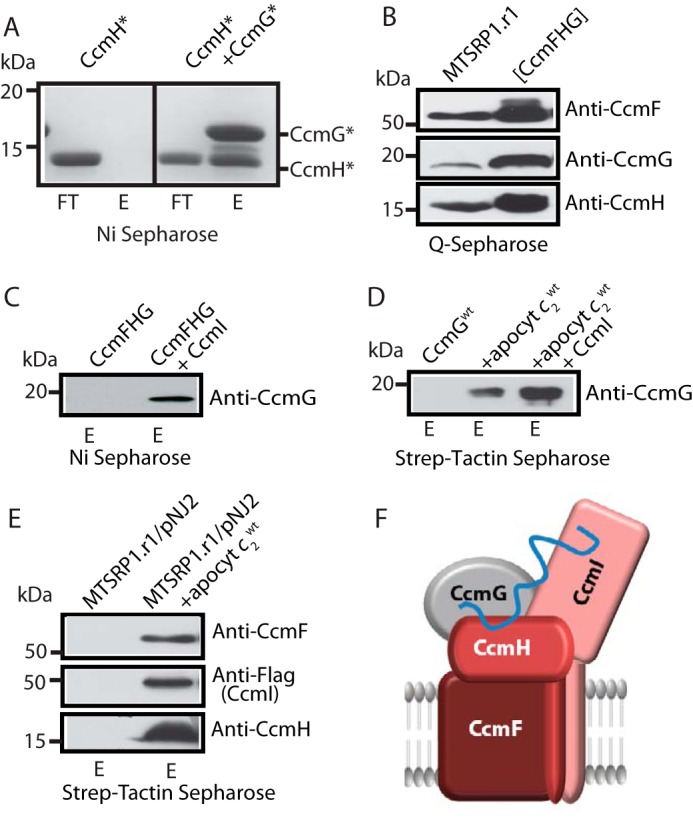Figure 3.

Protein–protein interactions between the apocyt c, thioredoxin CcmG, and heme ligation components CcmF, CcmH, and CcmI. A, co-purification of Cys-less FLAG-CcmH* with Cys-less His6-CcmG* using nickel-Sepharose resin is shown on the right panel. Note that FLAG-CcmH* does not bind to the resin in the absence of His6-CcmG* (left panel). In all panels, FT and E refer to flow-through and elution fractions, respectively. B, DDM-dispersed membrane proteins from R. capsulatus strain MTSRP1.r1 were separated using a Q-Sepharose column, and a fraction containing CcmF, CcmG, and CcmH co-eluting together was collected. 40 μg of total membrane proteins before fractionation (left lane) and 10 μg of the fraction containing CcmF, CcmG, and CcmH together (right lane) are shown. All proteins were detected by immunoblots using appropriate specific antibodies as indicated. C, co-purification of native CcmG from the CcmFGH-enriched fraction with purified CcmI. 10 μg of purified His10-CcmI was incubated with 100 μg of CcmFGH-containing fraction and re-purified in a nickel-Sepharose resin. Only in the presence of His10-CcmI is CcmG retained by the resin and found in the elution fraction (right lane). D, co-purification of equimolar concentration (∼1.5 μm) of His6-CcmGWT with Strep-apocyt c2WT using Strep-Tactin–Sepharose resin (middle lane). In the absence of apocyt c2, CcmG was not retained by the resin (left lane), and in the presence of His10-CcmI (∼0.5 μm) more His6-CcmG co-eluted with Strep-apocyt c2 (right lane). C and D, CcmG was detected by immunoblots using anti-CcmG-specific antibodies. E, 500 μg of DDM-dispersed membrane proteins from R. capsulatus strain MTSRP1.r1/pNJ2, containing CcmF, CcmH, and FLAG-CcmI were incubated with 10 μg of Strep-apocyt c2WT, which was then re-purified using Strep-Tactin-Sepharose resin. Binding to the Strep-Tactin column of the heme ligation components CcmF, CcmH, and FLAG-CcmI occurs only when apocyt c2WT is present (compare left and right lanes). Immunodetection was done with anti-CcmF, anti-CcmH, and anti-FLAG (for FLAG-CcmI detection) polyclonal antibodies, as appropriate. F, schematic representation of a hypothetical CcmFGHI-apocyt c complex that might occur during Ccm. Our data showing that apocyt c2 interacts with CcmG, CcmF, CcmH, and CcmI, together with CcmG interacting with the heme ligation core components CcmH, CcmI, and CcmF in the absence of apocyt c2, support the occurrence of such a multisubunit complex binding the apocyt substrates.
